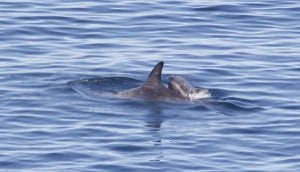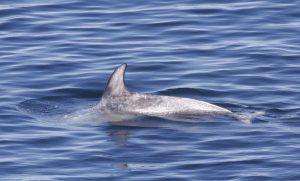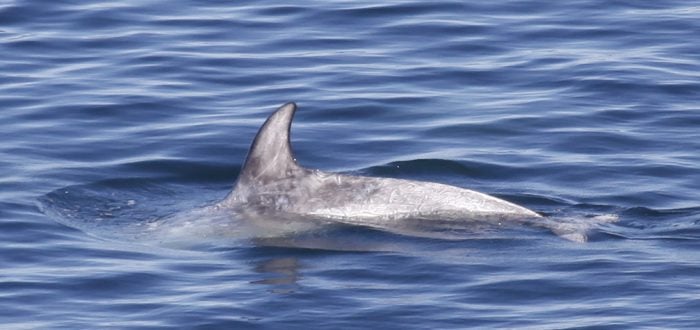By Nicola Hodgins, WDC Research Co-ordinator
Risso’s dolphins are an amazing yet relatively little-known species. I’ve been lucky enough to spend time studying them off the west coast of Scotland over the last 13 years and I’ve come to recognise individuals and have enjoyed observing long-term friendships and family groups. It’s always a joy to recognise familiar fins! Recognising individual dolphins is possible because Risso’s have distinct scars and marks on their dorsal fins and bodies, allowing individuals to be identified and recognised again and again – some for well over a decade. They get their characteristic scarring from interactions with other Risso’s dolphins – and sometimes other species of dolphin too – and from their prey, as they predominantly feed on squid and octopus.

We’ve been studying Risso’s dolphins around the Isle of Lewis since 2010 and as a direct result of our work, as well as others such as the Hebridean Whale and Dolphin Trust, the Scottish Government declared the North-east Lewis Marine Protected Area in December 2020. But Risso’s dolphins don’t just like to hang out in western waters, and in the past few years, they’ve become an increasingly sighted dolphin in other parts of Scotland too.
To unravel some of the mysteries that surround this species and help us get a better understanding of how they use Scottish waters, we have been collecting photos of Risso’s dolphins from around Orkney, Shetland and the north-east of Scotland. We contacted other researchers, members of the public, wildlife enthusiasts and tour operators asking them to send in photos, even historical ones, so that we could begin to piece together this Risso’s ‘jigsaw puzzle’ and we have been blown away by the response. Over 1500 photographs have been sent in already, some dating as far back as 2001. It’s thanks to these ‘citizen scientists’ that we are now able to publish two Photo-ID catalogues for Risso’s dolphins – one identifying individual dolphins seen in the waters of Orkney and north/east Scotland and the other showing individuals who have been spotted around Shetland and Fair Isle. So far we have identified 91 individual dolphins from Orkney and the North East of Scotland and 42 individuals from Shetland. Our initial analysis is also showing us that there may be some long-term friendships brewing between some of the Risso’s who like to hang out in this part of the country, and we’re fascinated to see what else we discover.

Through collecting and cataloguing photos of individuals, recognised by scars and marks, over the long term we hope to be able to understand more about where they go, what they do and who they do it with, ultimately helping us to understand more about their social structure and the importance of various habitats.
The publication of these catalogues is just the beginning and we still need your help. If you are lucky enough to take any pictures of Risso’s dolphins, please get in touch with us. We would love to include your images in future revisions of the catalogues, and you can look for yourself to see if the individuals you’ve seen have been spotted before. Equally if you have any images you’ve taken in the past, we would love to see those too.
It’s thanks to WDC supporters, WDC Shorewatch volunteers, fellow researchers and other members of the public, that we have been able to publish these Risso’s dolphin Photo-ID catalogues – citizen scientists around the world helping to protect the species they care about.
We’d like to say a huge thank you to everyone who has contributed, and we look forward to sharing more remarkable Risso’s with you in the future.
Download the Orkney & North/Northeast Scotland Risso’s Dolphin Photo-ID catalogue here.
Download the Shetland Risso’s Dolphin Photo-ID catalogue here.
Send us your images:
Email Katie Dyke, [email protected] (Mainland Scotland) or Emma Steel, [email protected] (Orkney, Shetland and Fair Isle).





